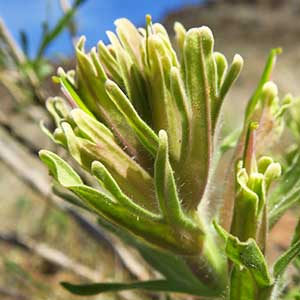Castilleja xanthotricha
Castilleja dissitiflora
John Day or yellow-hairy paintbrush, John Day paintbrush, yellow hair paintbrush, yellow-hair Indian paintbrush
Mount Hamilton paintbrush, Mt. Hamilton Indian paintbrush
few to several, ± decumbent to erect or ascending, unbranched, sometimes with short, leafy axillary shoots, hairs erect to spreading, long, soft, eglandular, mixed with short stipitate-glandular ones.
several to many, erect to ascending, unbranched, sometimes branched, hairs spreading, long, soft, mixed with shorter stipitate-glandular ones.
green, linear, lanceolate to broadly lanceolate, oblong, or cuneate, 0.8–5 cm, not fleshy, margins plane to wavy, involute, 0–5-lobed, apex acute, sometimes rounded;
lobes spreading, linear, arising below mid length, nearly as broad as center lobe, apex acute.
green, linear to narrowly or broadly lanceolate, (1–)3–5(–6) cm, not fleshy, margins wavy (obscure on many pressed specimens), involute, usually 0–3(–5)-lobed, apex broadly acute to rounded;
lobes widely spreading, linear to narrowly lanceolate, apex acute to acuminate.
3–14 × 1.5–4.5 cm;
bracts proximally greenish, rarely dull reddish purple, distally white to cream, rarely pale yellow or dull, pale pink (sharply differentiated from proximal coloration), lanceolate or oblong to narrowly ovate, (3–)5–7-lobed;
lobes ascending, linear to obovate, ± broadened distally, medium, long, proximal lobes arising below mid length, central lobe apex broadly rounded to truncate, others acute to rounded.
2.5–10 × 2–5.5 cm;
bracts proximally greenish, distally red to red-orange, narrowly lanceolate to broadly lanceolate, 3–5-lobed;
lobes spreading, distal, if present, ascending, linear or narrowly oblanceolate to triangular, proximals long, arising below mid blade, distals short, sometimes mere teeth, near apex of central lobe, sometimes wavy-margined, apex obtuse to rounded, sometimes acute.
curved, 17–23 mm;
tube 15–19 mm;
beak exserted, adaxially green, 5–8(–9) mm, puberulent, stipitate-glandular;
abaxial lip deep purple (color sometimes visible through calyx), green, pinkish, or pale yellow, ± prominent, slightly inflated, usually hidden in calyx, sometimes right at top of calyx, 2 mm, ca. 50% as long as beak;
teeth ascending, whitish, yellowish, pink, or green, 1–1.5 mm.
straight to slightly curved, 24–38 mm;
tube 14–21 mm;
beak exserted from calyx, adaxially green, 11–16.5(–18) mm;
abaxial lip green, reduced, visible or not through deep front cleft in calyx, 2 mm, 13% as long as beak;
teeth incurved, green, 1 mm.
colored as bracts, 15–26 mm;
abaxial and adaxial clefts 3.5–7 mm, 25–50% of calyx length, deeper than laterals, lateral 2–5 mm, 12–25% of calyx length;
lobes linear, oblong, or narrowly triangular, center lobe apex usually rounded, lobes acute to rounded.
whitish with green veins or green, sometimes purple, distally same color as bracts, sometimes with yellowish band below colored apices, 20–26(–29) mm;
abaxial clefts (8–)13–16(–19) mm, adaxial 7–12(–14) mm, clefts 35–50% of calyx length, deeper than laterals, lateral 2–6(–8) mm, 10–30% of calyx length;
lobes linear-lanceolate to lanceolate, apex obtuse to acute.
= 48.
= 48.
Castilleja xanthotricha
Castilleja dissitiflora
Castilleja xanthotricha is endemic to moderate elevations in the sagebrush hills of the John Day River drainage in north-central Oregon. N. H. Holmgren (1971) hypothesized that this tetraploid species is of allopolyploid hybrid origin between C. glandulifera and C. oresbia.
(Discussion copyrighted by Flora of North America; reprinted with permission.)
Castilleja dissitiflora is endemic to several mountain ranges in central and eastern Nevada, in the upper montane and lower subalpine zones. It has the deep abaxial calyx cleft of C. linariifolia and the stipitate-glandular, wavy-margined leaves of C. applegatei var. pinetorum. Based on morphological data, Holmgren suggested that it is an allopolyploid derived from hybridization of C. applegatei var. pinetorum and C. linariifolia. His proposal is plausible and should be further tested. Castilleja dissitiflora is a tetraploid, while both putative parental species have at least some diploid populations.
(Discussion copyrighted by Flora of North America; reprinted with permission.)
